South Korea E-Commerce Market Size
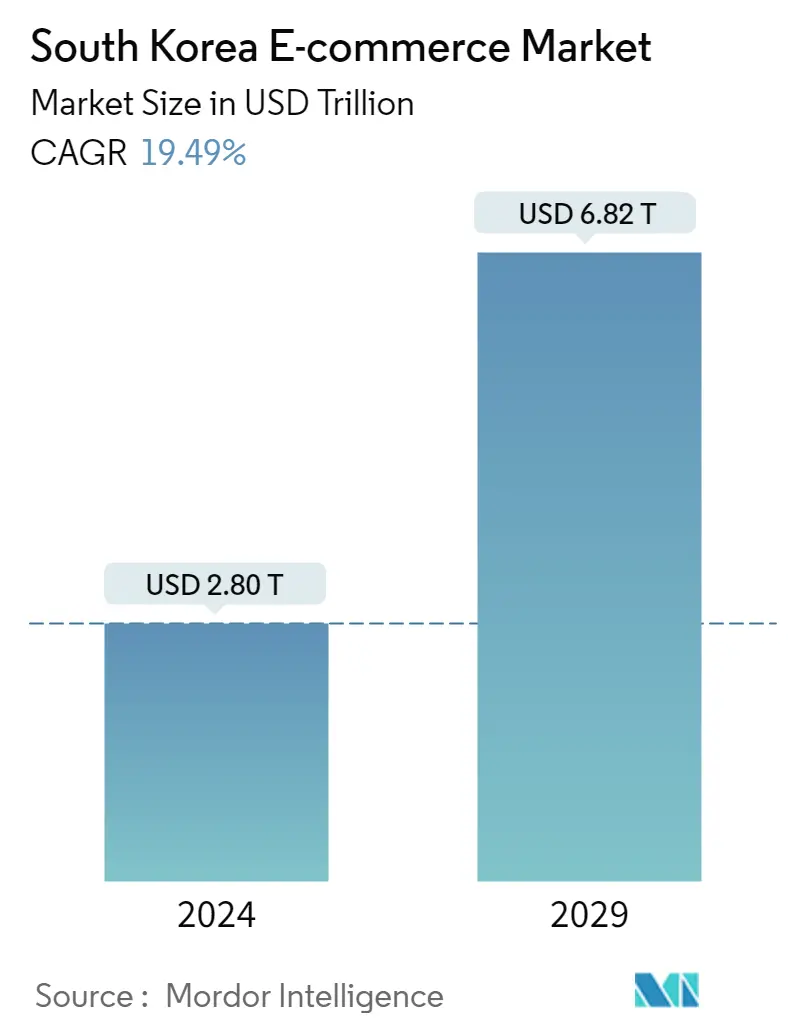
| Study Period | 2019 - 2029 |
| Base Year For Estimation | 2023 |
| Market Size (2024) | USD 2.80 Trillion |
| Market Size (2029) | USD 6.82 Trillion |
| CAGR (2024 - 2029) | 19.49 % |
| Market Concentration | Low |
Major Players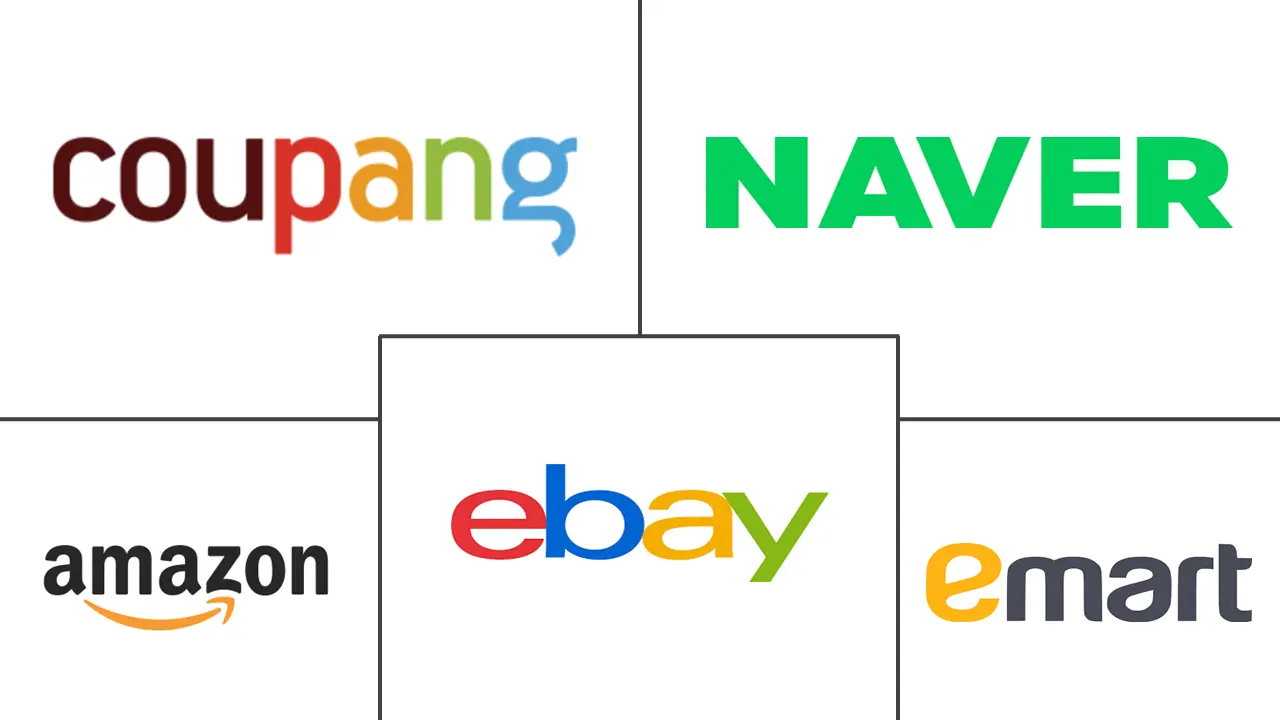
*Disclaimer: Major Players sorted in no particular order |
Need a report that reflects how COVID-19 has impacted this market and its growth?
South Korea E-Commerce Market Analysis
The South Korea E-commerce Market size is estimated at USD 2.80 trillion in 2024, and is expected to reach USD 6.82 trillion by 2029, growing at a CAGR of 19.49% during the forecast period (2024-2029).
Retail is being rewired by digitally inspired innovations that go beyond channel shift. Owing to the COVID-19 pandemic, new business models gained traction and commerce ecosystems evolved, altering how retailers and brands interacted with digitally connected audiences. The digital revolution resulted in a more convoluted and fragmented retail market during the previous decade. Marketplaces, direct-to-consumer brands, social commerce, live selling, and voice commerce are examples of the various paths to the end consumer.
- According to the International Trade Administration, E-commerce is a significant part of Korea's entire consumer industry and is continually rising. Korea is a technologically advanced country, with about 99.5% of Korean households having an internet connection through a computer, mobile phone, or another device.
- According to a Bank of Korea survey, credit cards are the most popular payment method for clients utilizing personal computers (PCs) and mobile platforms. Electronic payment services via PC and mobile are becoming more popular as online shopping continues to develop. The average daily utilization of the Payment Gateway (PG) service based on credit cards exceeded 16 million. Furthermore, mobile payment and digital wallet services like Samsung Pay and Naver Pay are gaining popularity.
- E-commerce is driving the Korean retail market forward. Traditional retail outlets are hurting as e-commerce grows rapidly. Consumers prefer to window shop in conventional stores but turn to retail internet sites to get the greatest bargains and complete their purchases. Convergence with other platforms is one of the most critical trends in internet retailing. Consumers want a one-stop shopping experience that includes product reviews and prices, purchasing, and paying with new online payment solutions associated with the platforms. Internet portal sites, social network services, TV home shopping, and other platforms now have online shopping functions, and the popularity of their platforms is growing.
- The majority of people's time and money is spent online. As a result, the rise in cybercrime and cyber dangers is unsurprising. As data theft and security breaches grow, so does the need to improve cybersecurity. Investing in more secure servers and checkout processes can remedy such issues. Consumers, above all, demand assurances about the security of their personal and financial data.
- To stay relevant in a rapidly digitizing market, Lotte Shopping, one of South Korea's leading conglomerates in the store-based retailing channel, established Lotte ON. This platform unites the online storefronts of Lotte's retail brands. While COVID-19 undoubtedly signaled to the corporation that physical retail locations would be restructured beginning in early 2020, Lotte's Shopping aimed to produce a seamless omnichannel that integrates its online and offline stores. Lotte ON wants to give customers individualized shopping experiences by making product recommendations based on previous purchases.
South Korea E-Commerce Market Trends
Food and Beverages sector to Register Significant Growth
- Food and beverage e-commerce has benefited from the growing demand for online grocery shopping. Although South Korea's vaccination program gradually established an increased level of confidence among local consumers to spend time outside the home by the end of 2021, their regular changes in terms of food consumption, which were greatly influenced by reduced outdoor activities such as work from home and remote learning, supported further strong growth for food and drink e-commerce.
- Foreign food businesses seeking to capitalize on South Korea's e-commerce growth might encourage localization to optimize reach, with the country having sizable per-individual online sales worldwide.
- Moreover, according to the Korean Statistical Information Service (KOSIS), the transaction value of online food and beverage purchases was roughly KRW 7.19 trillion (USD 5.54 trillion) in the first quarter of 2023, a 6.9% increase in sales from the previous quarter, Q4 2022. Over the years, the transaction value has gradually grown. Such a significant transaction value would considerably contribute to e-commerce growth in the country.
- The market has witnessed a significant increase in the internet channel's nationwide percentage of fresh food purchases. However, as consumers' meal preferences have evolved, they increasingly seek out different cuisines as substitutes for Korean-style recipes, buying fresh components such as imported meat and Western veggies or meal packages in small quantities. Such trends are considerably contributing to online food deliveries across various food chains, thereby driving e-commerce sales in the country.
- The accessibility of online grocery shopping is expected to retain current customers, as many of them have grown accustomed to having large grocery items brought to their homes. The growing number of single-person and dual-income households, which fueled the channel's growth before the pandemic, is expected to continue to be the primary driver. At the same time, the influx of new customers, such as older adults, is anticipated to accelerate the rapid growth of food and drink e-commerce over the forecast period.
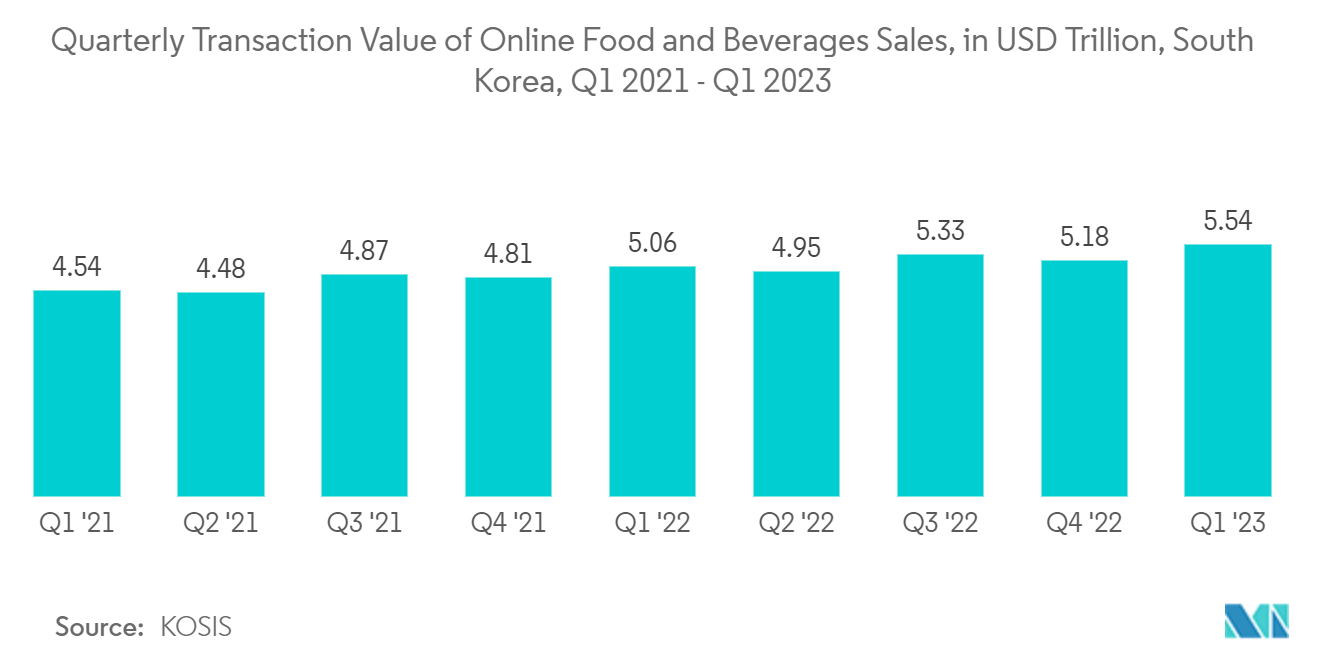
Fashion and Apparel sector to Hold Significant Market Share
- South Korea is now regarded as one of the East's most significant emerging fashion capitals, with Seoul Fashion Week becoming increasingly famous. Saturation in the West has caused many businesses to change their emphasis and seek out emerging markets, which is expected to develop the fashion and apparel industries in the country.
- Moreover, South Korea has an economically expanding fashion industry, with several local names accounting for a sizable portion of total fashion sales. Aside from that, Seoul has a powerful impact on street style, particularly among the younger groups.
- Furthermore, South Korea has its own set of patterns and retail and online players. Although there is a strong preference for Western luxury goods, customers in the nation have individual preferences for them. As a result, the strategy for reaching these consumers must be completely tailored to their preferences. South Koreans use a variety of social media applications, both prominent Western and local, which is expected to account for e-commerce revenue generation considerably.
- Local celebrities and pop icons also have a big influence on South Koreans. Moreover, many Western companies use these personalities as brand ambassadors. Their distinct style can influence public opinion and set significant national developments. These trends could potentially attract large players to invest in fashion e-commerce activities to enhance their offerings across the country.
- Consumer demands in the fashion market are becoming increasingly complicated and varied due to increased consumption and rising disposable incomes. Other factors include the growing desire for individuality and personalized fashion, the growth of life-enriching consumption such as leisure and cultural activities, an increase in internet sales, an aging population, and a change in core consumers. Such trends would significantly increase e-commerce sales in the fashion industry.
- Furthermore, according to the Korean Statistical Information Service (KOSIS), the transaction value of fashion products or accessories through online stores in South Korea was expected to be around KRW 3.7 trillion (USD 2.78 billion) in 2022. Online purchases of clothing and other fashion products have gradually grown in recent years, thereby driving e-commerce market growth in the fashion and apparel industries in the country.
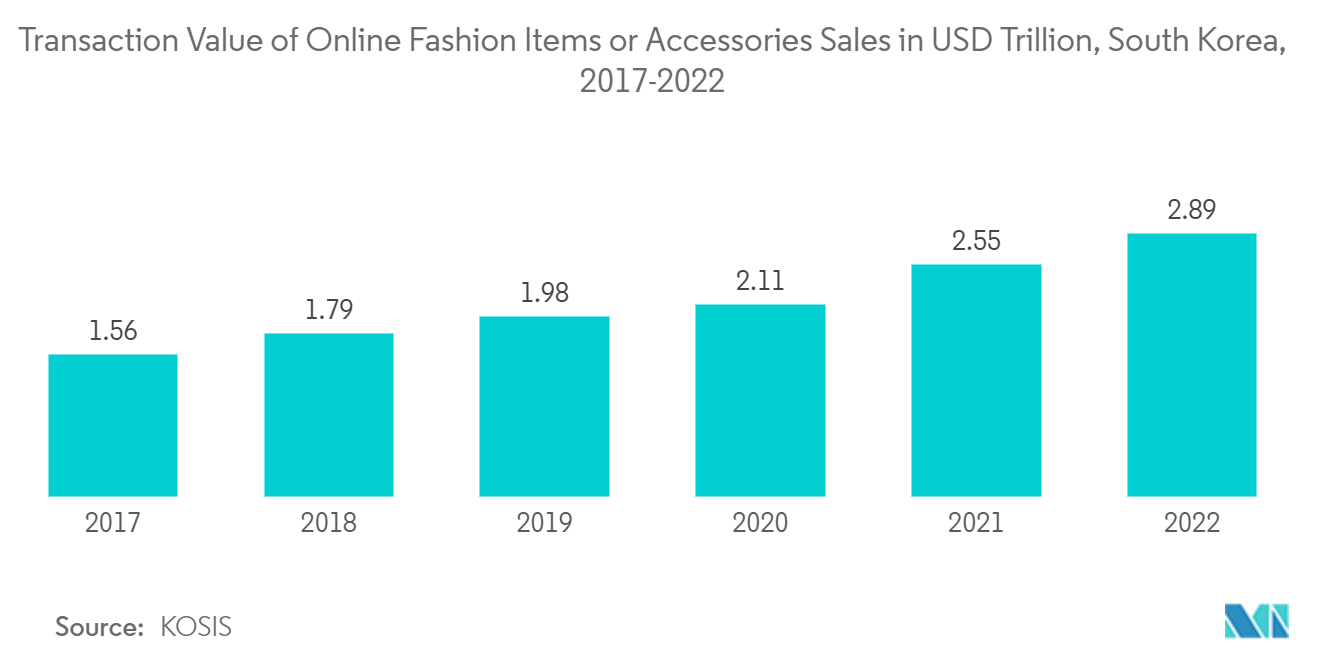
South Korea E-Commerce Industry Overview
The South Korean e-commerce market is fragmented, with the presence of major players like Coupang Corp., Naver Shopping, eBay Inc., Amazon.com Inc., and Emart. Players in the market are adopting strategies such as partnerships, innovations, mergers, investments, and acquisitions to enhance their service offerings and gain a sustainable competitive advantage. Furthermore, the growing popularity and adoption of e-commerce attract newer players to the market, thus increasing the competitive rivalry in the South Korean e-commerce market.
In April 2023, SSG.com launched Randers Day Fever, allowing customers to buy products with half-price discounts. In the shopping category, eight special products are released every day at 9:00 a.m. through Suk.com.
In March 2023, TMON announced that the company had launched the 'Qx Prime' exclusive hall based on fast delivery. If the customer orders before 2 p.m., the product will be shipped out the same day and delivered the next day. This will allow the company to stay ahead of its competitors.
Furthermore, to increase its market share, in March 2023, TMON extended its partnership program and collaborated with the youth cooperative 'Two Dog.' Through this, it has launched five types of homemade snacks, a new product of the companion animal NPB. In addition, the company has announced that it will donate some of the proceeds from this sale to rescue abandoned dogs and strive to spread good consumption. This will help the company attract more pet owners.
South Korea E-Commerce Market Leaders
Coupang Corp.
Naver Shopping
eBay Inc.
Amazon.com Inc.
EMart
*Disclaimer: Major Players sorted in no particular order
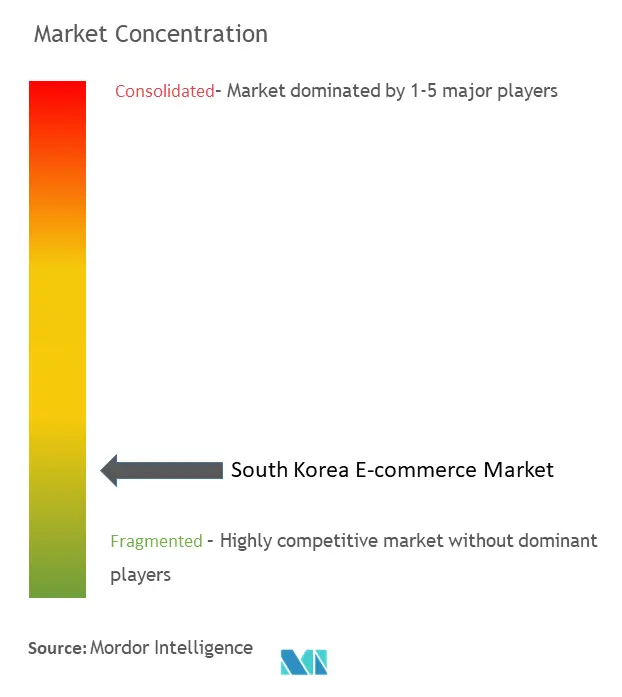
South Korea E-Commerce Market News
- April 2023: SSG.com announced that it would introduce a personnel system that reflects the grade system competency/performance-based promotion flexible compensation system to secure competitiveness in the e-commerce business and future growth strategy.
- April 2023: TMON announced that the company would open a 'Sports & Leisure Special Hall' and introduce popular sports and outdoor items at special prices. An additional 8% discount is also available when paying with Kakao Pay. This will help athletic people stretch in warm spring weather.
South Korea E-Commerce Market Report - Table of Contents
1. INTRODUCTION
1.1 Study Assumptions and Market Definition
1.2 Scope of the Study
2. RESEARCH METHODOLOGY
3. EXECUTIVE SUMMARY
4. MARKET INSIGHTS
4.1 Market Overview
4.2 Industry Attractiveness - Porter's Five Forces Analysis
4.2.1 Bargaining Power of Suppliers
4.2.2 Bargaining Power of Buyers
4.2.3 Threat of New Entrants
4.2.4 Threat of Substitute Products
4.2.5 Intensity of Competitive Rivalry
4.3 Key Market Trends and Share of E-commerce of Total Retail Sector
4.4 Impact of COVID-19 on the Market
5. MARKET DYNAMICS
5.1 Market Drivers
5.1.1 High Smartphone and Internet Penetration Across the Country
5.1.2 High Demand for Food Delivery Services
5.2 Market Challenges
5.2.1 Data Security
5.3 Analysis of Key Demographic Trends and Patterns Related to E-commerce Industry in South Korea
5.4 Analysis of the Key Modes of Transaction in the E-commerce Industry in South Korea
5.5 Analysis of Cross-border E-commerce Industry in South Korea
5.6 Current Positioning of South Korea in the E-commerce Industry in Asia-Pacific
6. MARKET SEGMENTATION
6.1 By Type
6.1.1 B2C E-commerce
6.1.1.1 Application
6.1.1.1.1 Beauty and Personal Care
6.1.1.1.2 Consumer Electronics
6.1.1.1.3 Fashion and Apparel
6.1.1.1.4 Food and Beverage
6.1.1.1.5 Furniture and Home
6.1.1.1.6 Other Applications
6.1.2 B2B E-commerce
7. COMPETITIVE LANDSCAPE
7.1 Company Profiles*
7.1.1 Coupang Corp.
7.1.2 Naver Shopping
7.1.3 eBay Inc.
7.1.4 Amazon.com Inc.
7.1.5 EMart
7.1.6 Interpark.com
7.1.7 Tmon Inc.
7.1.8 11Street Co. Ltd.
7.1.9 SSG.com Corp.
7.1.10 Apple Inc.
8. INVESTMENT ANALYSIS
9. FUTURE OF THE MARKET
South Korea E-Commerce Industry Segmentation
E-commerce refers to selling clothing, electronics, furniture, books, cosmetics, and other items over the Internet. Companies that provide home delivery services, such as e-commerce and m-commerce, are included in this industry. Retailers and their consumers conduct sales transactions using information technology, such as the telephone and the Internet, and merchandise is often delivered via mail or courier. Direct mailers that sell their merchandise and retail through online websites are also included in the e-commerce industry.
The e-commerce market for the study defines the revenues generated from B2C e-commerce and B2B e-commerce in South Korea. The study is segmented by type (B2C e-commerce, applications (beauty and personal care, consumer electronics, fashion and apparel, food and beverages, furniture and home, and other applications), and B2B e-commerce). The market sizes and forecasts are provided in terms of value in USD billion for all the segments. The analysis is based on the market insights captured through secondary research and the primaries. The report tracks key market parameters, underlying growth influencers, and major vendors operating in the industry, which supports market estimations and growth rates over the forecast period. The market sizes and forecasts are provided in terms of value in USD for all the segments.
| By Type | ||||||||||
| ||||||||||
| B2B E-commerce |
South Korea E-Commerce Market Research FAQs
How big is the South Korea E-commerce Market?
The South Korea E-commerce Market size is expected to reach USD 2.80 trillion in 2024 and grow at a CAGR of 19.49% to reach USD 6.82 trillion by 2029.
What is the current South Korea E-commerce Market size?
In 2024, the South Korea E-commerce Market size is expected to reach USD 2.80 trillion.
Who are the key players in South Korea E-commerce Market?
Coupang Corp., Naver Shopping, eBay Inc., Amazon.com Inc. and EMart are the major companies operating in the South Korea E-commerce Market.
What years does this South Korea E-commerce Market cover, and what was the market size in 2023?
In 2023, the South Korea E-commerce Market size was estimated at USD 2.34 trillion. The report covers the South Korea E-commerce Market historical market size for years: 2019, 2020, 2021, 2022 and 2023. The report also forecasts the South Korea E-commerce Market size for years: 2024, 2025, 2026, 2027, 2028 and 2029.
South Korea Ecommerce Industry Report
Statistics for the 2023 South Korea Ecommerce market share, size and revenue growth rate, created by Mordor Intelligence™ Industry Reports. South Korea Ecommerce analysis includes a market forecast outlook to 2029 and historical overview. Get a sample of this industry analysis as a free report PDF download.
